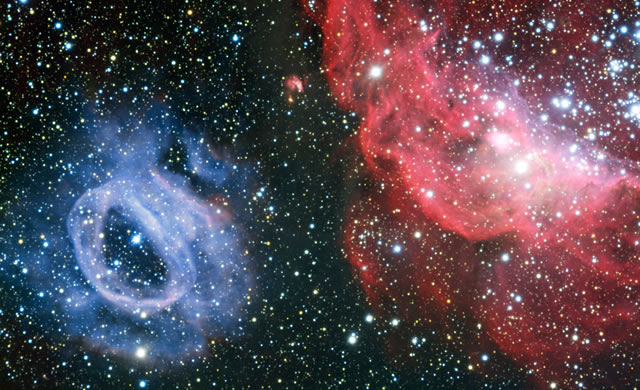
Il VLT (Very Large Telescope) dell’ESO ha colto questa immagine di una regione di formazione stellare molto interessante nella Grande Nube di Magellano – una delle galassie satellite della Via Lattea. Questa fotografia così nitida rivela due particolari nubi incandescenti di gas: NGC 2014, in rosso, e NGC 2020, la sua vicina blu. Sono molto diverse tra di loro, ma entrambe sono state scolpite dai potenti venti stellari di stelle caldissime appena nate che risplendono all’interno del gas facendolo brillare.
L’immagine è stata ottenuta dal VLT (Very Large Telescope) all’Osservatorio di Paranal dell’ESO, in Cile – il miglior sito nel sud del mondo per le osservazioni astronomiche. Ma anche senza l’aiuto di un telescopio come il VLT, uno sguardo verso la costellazione australe del Dorado (identificata con un pesce spada o una lampuga, dorado in spagnolo) in una notte buia e limpida svela una macchia sfuocata che a prima vista sembra proprio una nube nell’atmosfera terrestre. Almeno, questa è probabilmente stata la prima impressione dell’esploratore Ferdinando Magellano durante il suo famoso viaggio nell’emisfero australe nel 1519. Anche se Magellano stesso fu ucciso nelle Filippine prima del suo ritorno, i superstiti del suo equipaggio annunciarono l’esistenza di questa nube e della sua sorella minore al ritorno in Europa, così che queste due piccole galassie furono poi chiamate in onore di Magellano. Non c’è dubbio che debbano essere state viste anche da altri esploratori europei prima di lui e da osservatori dell’emisfero australe, anche se ciò non risulta sia mai stato segnalato. La Grande Nube di Magellano (LMC per Large Magellanic Cloud) produce attivamente nuove stelle. Alcune della regioni di formazione stellare sono visibili a occhio nudo, per esempio la famosa Nebulosa Tarantola. Ci sono anche altre regioni più piccole, ma non meno interessanti, che i telescopi rivelano nei loro dettagli più intricati. Questa nuova immagine del VLT esplora la coppia maleassortita di nubi formata da NGC 2014 e NGC 2020. La nube rosata a destra, NGC 2014, è una nube incandescente formata soprattutto da idrogeno gassoso. Contiene un ammasso di stelle giovani e calde. La radiazione energetica prodotta da queste nuove stelle strappa gli elettroni dagli atomi dell’idrogeno circostante, li ionizza e produce il caratteristico bagliore rosso.
Fonte/Leggi tutto → ESO.org
ESO’s Very Large Telescope has captured an intriguing star-forming region in the Large Magellanic Cloud — one of the Milky Way’s satellite galaxies. This sharp image reveals two distinctive glowing clouds of gas: red-hued NGC 2014, and its blue neighbour NGC 2020. While they are very different, they were both sculpted by powerful stellar winds from extremely hot newborn stars that also radiate into the gas, causing it to glow brightly.
This image was taken by the Very Large Telescope (VLT) at ESO’s Paranal Observatory in Chile — the best place in the southern hemisphere for astronomical observing. But even without the help of telescopes like the VLT, a glance towards the southern constellation of Dorado (The Swordfish or Dolphinfish) on a clear, dark night reveals a blurry patch which, at first sight, appears to be just like a cloud in the Earth’s atmosphere. At least, this may have been explorer Ferdinand Magellan’s first impression during his famous voyage to the southern hemisphere in 1519. Although Magellan himself was killed in the Philippines before his return, his surviving crew announced the presence of this cloud and its smaller sibling when they returned to Europe, and these two small galaxies were later named in Magellan’s honour. However, they were undoubtedly seen by both earlier European explorers and observers in the southern hemisphere, although they were never reported. The Large Magellanic Cloud (LMC) is actively producing new stars. Some of its star-forming regions can even be seen with the naked eye, for example, the famous Tarantula Nebula. However, there are other smaller — but no less intriguing — regions that telescopes can reveal in intricate detail. This new VLT image explores an oddly mismatched pair: NGC 2014 and NGC 2020. The pink-tinged cloud on the right, NGC 2014, is a glowing cloud of mostly hydrogen gas. It contains a cluster of hot young stars. The energetic radiation from these new stars strips electrons from the atoms within the surrounding hydrogen gas, ionising it and producing a characteristic red glow.
Source/Continue reading → ESO.org





















